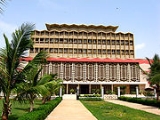
National Museum of Pakistan
Encyclopedia

Karachi
Karachi is the largest city, main seaport and the main financial centre of Pakistan, as well as the capital of the province of Sindh. The city has an estimated population of 13 to 15 million, while the total metropolitan area has a population of over 18 million...
, Sindh
Sindh
Sindh historically referred to as Ba'ab-ul-Islam , is one of the four provinces of Pakistan and historically is home to the Sindhi people. It is also locally known as the "Mehran". Though Muslims form the largest religious group in Sindh, a good number of Christians, Zoroastrians and Hindus can...
, Pakistan
Pakistan
Pakistan , officially the Islamic Republic of Pakistan is a sovereign state in South Asia. It has a coastline along the Arabian Sea and the Gulf of Oman in the south and is bordered by Afghanistan and Iran in the west, India in the east and China in the far northeast. In the north, Tajikistan...
. National Museum of Pakistan was established in Frere Hall
Frere Hall
Frere Hall is one of the few well-preserved buildings from the days of the British Raj that still exists in Karachi, Sindh, Pakistan.It was built in honour of Sir Henry Bartle Edward Frere , who was known for promoting economic development in Karachi.-Location:The Hall is located between Abdullah...
on April 17, 1950, replacing the defunct Victoria Museum. Frere Hall itself was built in 1865 as a tribute to Sir Bartle Frere
Henry Bartle Frere
Sir Henry Bartle Edward Frere, 1st Baronet, GCB, GCSI, was a British colonial administrator.-Early life:Frere was born at Clydach House, Clydach, Monmouthshire, the son of Edward Frere, manager of Clydach Ironworks...
, a Commissioner of Sind
Sind Division
The Sind Division was the name of Sindh after being annexed by the Bombay Presidency province of British India in 1843 , following a British Indian conquest led by then Major-General Charles Napier. The region separated from the Bombay Presidency to become the Sind Province on 1936-04-01....
during the 19th century. The basic objective of establishing National Museum was to collect, preserve, study, and exhibit the records of the cultural history of Pakistan
Pakistan
Pakistan , officially the Islamic Republic of Pakistan is a sovereign state in South Asia. It has a coastline along the Arabian Sea and the Gulf of Oman in the south and is bordered by Afghanistan and Iran in the west, India in the east and China in the far northeast. In the north, Tajikistan...
and to promote a learned insight into the personality of its people. Once the Museum was inaugurated then the Government of Pakistan
Pakistan
Pakistan , officially the Islamic Republic of Pakistan is a sovereign state in South Asia. It has a coastline along the Arabian Sea and the Gulf of Oman in the south and is bordered by Afghanistan and Iran in the west, India in the east and China in the far northeast. In the north, Tajikistan...
deemed it wise to constitute an Advisory Council in 1950 with a primary duty to counsel the Museum on the issues of enriching its collection through new acquisitions and purchase of antiquities and works of Arts.
Galleries
The Museum was shifted to the present premises (located in Burnes Garden, Dr. Zia-ud-din Road) in 1970. At that time there were only four galleries in the Museum. However, at present there are a total of 11 Galleries in the Museum including an exquisite “Quran Gallery”. As a matter of fact National Museum has more than 300 copies of the Quran (all are exactly the same), out of which around 52 rare manuscripts are on display in “Quran Gallery”. The Museum also contains an important collection of items relating to Pakistan's Cultural heritage. Some other galleries display Indus Civilization artifacts, GandharaGandhara
Gandhāra , is the name of an ancient kingdom , located in northern Pakistan and eastern Afghanistan. Gandhara was located mainly in the vale of Peshawar, the Potohar plateau and on the Kabul River...
Civilization Sculptures, Islamic Art, Miniature Paintings, Ancient Coins and Manuscripts documenting Pakistan's Political History. There is also an interesting Ethnological Gallery with life size statues of different ethnicities living in the four provinces of Pakistan.

